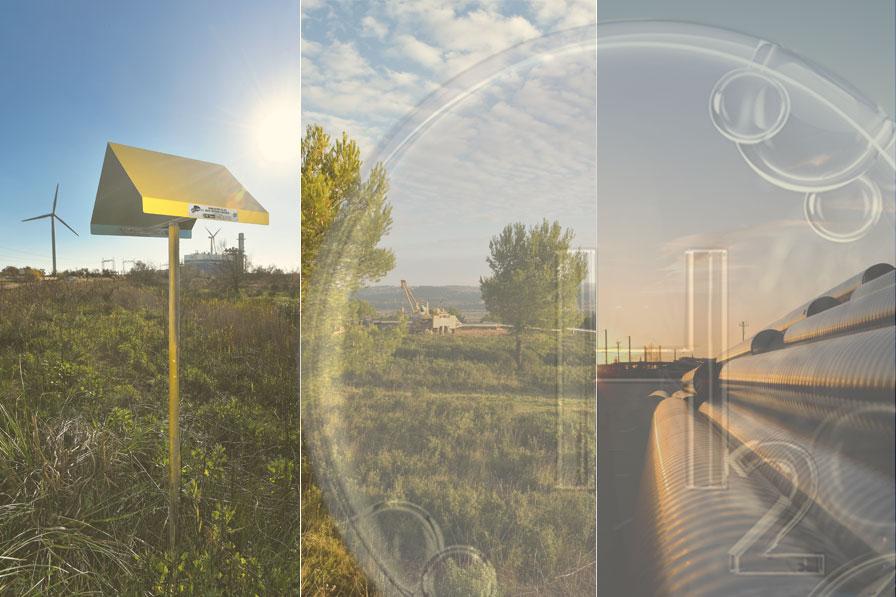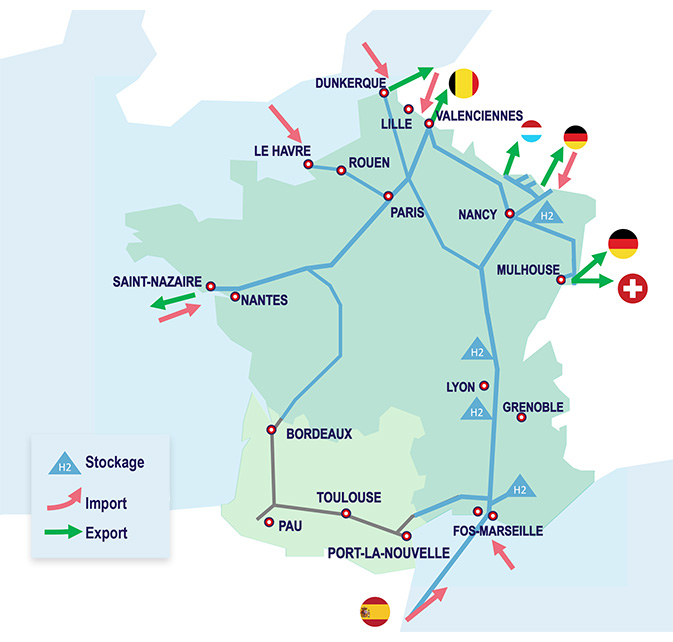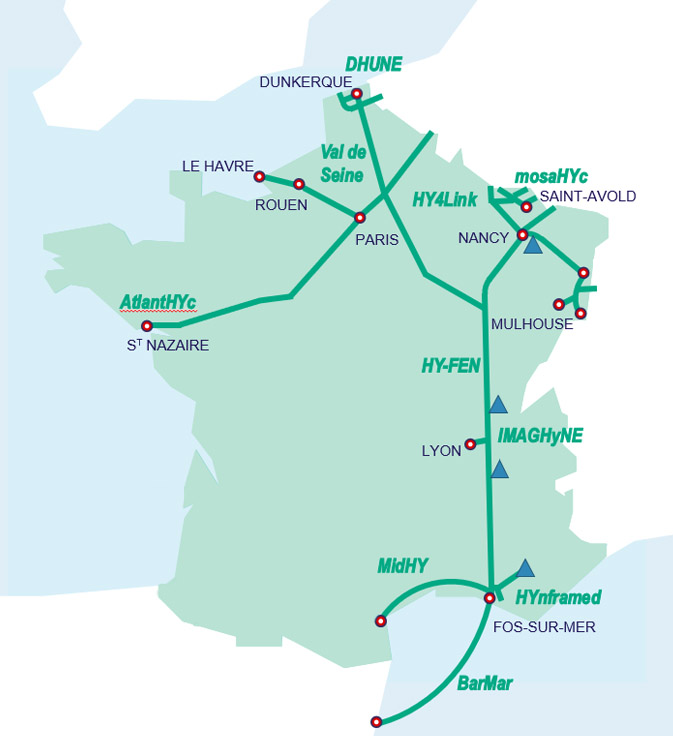Transportation of hydrogen

GRTgaz is supporting the development of low-carbon and renewable hydrogen by designing future hydrogen transportation infrastructures and helping to create a single, open and accessible market at local, national and European level.
Developing hydrogen transportation networks in France and Europe
Industrial hubs and progressive territorial coverage
GRTgaz is preparing to develop an open hydrogen transportation network, either by converting existing gas pipelines or by building new infrastructures.
The hydrogen development strategy has three main strands:
- Develop open-access hydrogen transportation networks in France’s main industrial regions: these high-CO2-emitting areas combine a substantial need for decarbonisation with a high demand for energy and capacities to produce low-carbon hydrogen. The creation of local hydrogen transportation infrastructures provides a link between producers and consumers in a regional context. It guarantees the security and flexibility of supply while offering a high-performance, local solution for decarbonising industrial uses.
- Gradually serve the entire country by connecting industrial regions together and linking up production and consumption areas to hydrogen storage facilities.
- Work to develop European interconnections by organising and steering cross-border initiatives and the H2med European corridor project. The ultimate aim is to contribute to the creation of a competitive and accessible single European hydrogen market through the construction of transportation infrastructures.
“The future of hydrogen and the decarbonisation of its uses depend, to a large extent, on the price of hydrogen and consumer confidence in the security of supply. The latter presupposes a hydrogen transportation infrastructure that is available, reliable and robust enough to meet customers' needs. Driven by this conviction, GRTgaz is working on the development of local, national and cross-border transportation networks that are efficient, dedicated to hydrogen and accessible to all.”Jana Kavicka
H2 Business Developer
GRTgaz’s hydrogen infrastructure projects
With this in mind, GRTgaz is working on numerous projects with local and cross-border hydrogen stakeholders (consumers, producers, local and regional authorities, transport operators, etc.). By 2030, the first regional hydrogen transportation networks will be brought into service around the industrial centres that will be the future consumers of hydrogen.
List of projects for regional and cross-border hydrogen hubs in industrial regions:
- MosaHYc: a cross-border hydrogen network project involving the conversion of existing gas pipelines, linking the industrial regions of France, Germany and Luxembourg: the “Grande Région Hydrogène” (GRH).
- RHYn: a project aiming to develop the first hydrogen network in the Upper Rhine region by connecting the Mulhouse industrial agglomeration with the German hydrogen network.
- Franco-Belgian corridor: project to develop a large-scale cross-border network from the port of Dunkirk across the entire Franco-Belgian border region.
- WHHYN: the first cross-border hydrogen transport network between France and Belgium.
- DHUNE: a hydrogen infrastructure project in the Dunkirk industrial zone, with an extension to Belgium planned.
- HYnframed: a hydrogen network project in Fos-sur-Mer, connected to the Manosque storage facility, to ensure a secure supply for local manufacturers.
- HY-FEN: a hydrogen network project running from the South of France to the German border. It forms part of the H2med corridor.
European corridor project:
H2med : project for a large-scale renewable hydrogen corridor in Europe, with the first BarMar element linking Barcelona and Marseille. H2med will be one of several large-scale European hydrogen transportation corridors linking southern and central Europe.
>> H2med project website
GRTgaz H2 under study

H2 infrastructure projects in development

>>> Télécharger les cartes (Réseau H2 à l’étude et projets en développement)
The key stages in a hydrogen transport infrastructure project
It can take more than four years from the time the opportunity arises to build a hydrogen transport infrastructure to the start of construction. This period is divided into major stages, including four levels of preliminary studies:
- Opportunity studies, also known as pre-feasibility studies. This general diagnosis, based on mapping around an indicative route, is used to sketch out a technical and regulatory perimeter, as well as an initial estimate of the project's schedule and costing.
These studies lead to a call for expressions of interest (AMI, or Open Season), organised to identify the economic players - potential hydrogen producers as well as industrial consumers - interested in the infrastructure project. - Feasibility studies, sometimes also referred to as pre-FEED studies. Carried out on a perimeter refined using the results of the AMI, these studies make it possible to specify all the aspects of the project:
development scenarios, route and sizing of the future network, environmental constraints and impact minimisation measures, industrial safety and the regulatory and administrative context. The costing and implementation schedule become more precise. - Basic engineering studies, also known as FEED (Front-End Engineering Design). They are even more detailed than the last ones, and are required to compile the administrative file, which is used to submit the application for planning permission and operating licence, as well as any declaration of public interest (DUP).
For customers who have expressed an interest in the project, they also lead to a binding price offer. Once the contractual commitment has been obtained, GRTgaz can make the investment decision. - Detailed engineering studies. The plans, schedule and costs of the forthcoming worksite have been finalised. GRTgaz's teams conduct calls for tender for procurement and construction services. At the same time, the government is examining the application for planning permission and operating licence.
- Construction. This stage can begin as soon as the construction and operating permits have been received: this means that GRTgaz is obliged to build as authorised by the French authorities. At the end of the works, the teams on site carry out technical tests, then prepare for the gas connection. Commissioning and operation can begin.
Developing the hydrogen market in France
GRTgaz is participating in the development of the hydrogen market through consultations and calls for projects, aimed at identifying the potential for production and consumption.
- Low-carbon and renewable hydrogen market stakeholders’ consultation: carried out in 2021 and 2022, this participatory process launched by GRTgaz enabled us to better identify the needs of future hydrogen producers and consumers, particularly in terms of logistics and transport. To take this process one step further, in 2022, GRTgaz initiated regional workshops in France’s major industrial regions, confirming the strong local dynamics.
Consultation and dialogue with market stakeholders
Hydrogen network projects

